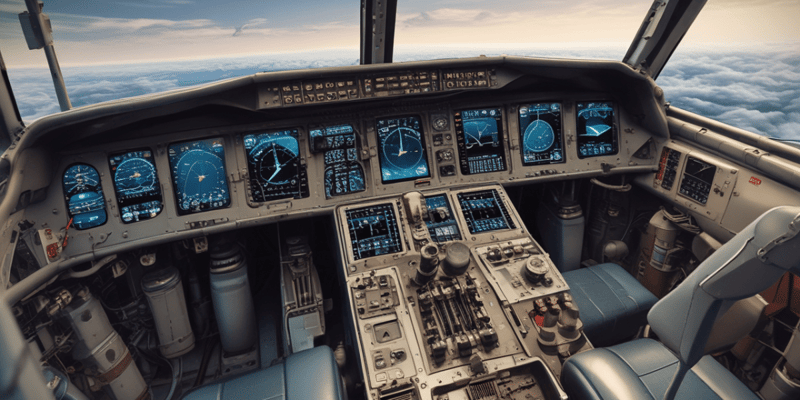Questions and Answers
What components are included in the primary Flight Control System (FCS)?
The primary FCS includes the components that control the two ailerons, six spoilers, two elevators, and one rudder.
How are the flight control surfaces actuated and controlled?
The flight control surfaces are hydraulically actuated and electrically controlled with fly-by-wire technology.
What is the significance of the System Power On Self-Test (SPOST) in the aircraft's flight control system?
The SPOST is a feature of the FCC channels that runs when power is first applied, and it checks the system for proper functioning.
How does the aircraft's control system handle the situation when both FCCs (all four channels) are inoperative?
Signup and view all the answers
What are the primary flight control surfaces that remain operational if one hydraulic system is lost?
Signup and view all the answers
What is the purpose of the Backup Flight Control Unit (BFCU)?
Signup and view all the answers
What are the two types of primary flight control surface actuators mentioned in the text?
Signup and view all the answers
What are the three modes of operation for the EBHA?
Signup and view all the answers
What are the sub-modes of the Normal mode under the Flight Control System (FCS)?
Signup and view all the answers
What is the pitch response at speeds above approximately 135 KCAS?
Signup and view all the answers
Under what conditions will the FCS be in the Cruise sub-mode?
Signup and view all the answers
What indications will be displayed if the aircraft is near its angle of attack (AOA) limit value of 0.96?
Signup and view all the answers
What conditions need to be satisfied for the Flight Control System (FCS) to be in the AOA limiting sub-mode?
Signup and view all the answers
What triggers the entry into the AOA limiting sub-mode, and what are the indications of being in this sub-mode?
Signup and view all the answers
What are the conditions for the Flight Control System (FCS) to be in Alternate mode, and how is it primarily indicated?
Signup and view all the answers
What behavior is expected while in Direct mode, and how is it primarily indicated?
Signup and view all the answers
What are the conditions for the Flight Control System (FCS) to be in AOA limiting sub-mode, and what are the indications of being in this sub-mode?
Signup and view all the answers
What conditions need to be satisfied for the Flight Control System (FCS) to be in Alternate mode, and how is it primarily indicated?
Signup and view all the answers
How does the aircraft's control system handle the situation when both FCCs (all four channels) are inoperative?
Signup and view all the answers
What is the significance of the System Power On Self-Test (SPOST) in the aircraft's flight control system?
Signup and view all the answers
Under what conditions will the Flight Control System (FCS) be in the AOA limiting sub-mode, and how does the system handle the situation during landing and flare?
Signup and view all the answers
What is the purpose of the AOA limiting sub-mode in the Flight Control System (FCS)?
Signup and view all the answers
How is the entry into the AOA limiting sub-mode triggered, and what are the indications of being in this sub-mode?
Signup and view all the answers
Under what conditions will the Flight Control System (FCS) be in Alternate mode, and how is it primarily indicated?
Signup and view all the answers
What is the behavior of the Flight Control System (FCS) in Direct mode, and how is it primarily indicated?
Signup and view all the answers
What are the conditions for the Flight Control System (FCS) to enter the Yaw Control sub-mode, and what is the function of the yaw damper in this sub-mode?
Signup and view all the answers




